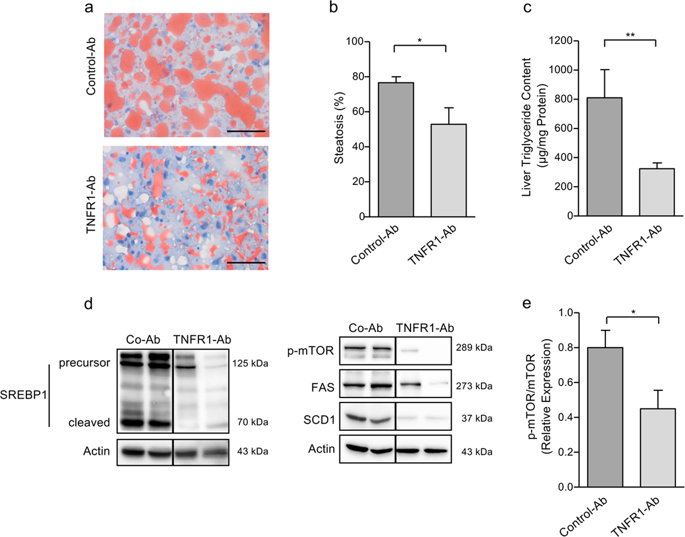Cell Death & Disease ( IF 9 ) Pub Date : 2020-03-31 , DOI: 10.1038/s41419-020-2411-6 Franziska Wandrer , Stephanie Liebig , Silke Marhenke , Arndt Vogel , Katharina John , Michael P. Manns , Andreas Teufel , Timo Itzel , Thomas Longerich , Olaf Maier , Roman Fischer , Roland E. Kontermann , Klaus Pfizenmaier , Klaus Schulze-Osthoff , Heike Bantel

|
Non-alcoholic fatty liver disease (NAFLD) shows an increasing prevalence and is associated with the development of liver fibrosis and cirrhosis as the major risk factors of liver-related mortality in this disease. The therapeutic possibilities are limited and restricted to life style intervention, since specific drugs for NAFLD are unavailable so far. TNFα has been implicated as a major pathogenic driver of NAFLD. TNFα-mediated liver injury occurs mainly via TNF-receptor-1 (TNFR1) signaling, whereas TNFR2 mediates protective pathways. In this study, we analyzed the therapeutic effects of a novel antibody, which selectively inhibits TNFR1 while retaining protective TNFR2 signaling in a high-fat diet (HFD) mouse model of NAFLD. Mice were fed with HFD for 32 weeks and treated with anti-TNFR1-antibody or control-antibody for the last 8 weeks. We then investigated the mechanisms of TNFR1 inhibition on liver steatosis, inflammatory liver injury, insulin resistance and fibrosis. Compared to control-antibody treatment, TNFR1 inhibition significantly reduced liver steatosis and triglyceride content, which was accompanied by reduced expression and activation of the transcription factor SREBP1 and downstream target genes of lipogenesis. Furthermore, inhibition of TNFR1 resulted in reduced activation of the MAP kinase MKK7 and its downstream target JNK, which was associated with significant improvement of insulin resistance. Apoptotic liver injury, NAFLD activity and alanine aminotransferase (ALT) levels, as well as liver fibrosis significantly decreased by anti-TNFR1 compared to control-antibody treatment. Thus, our results suggest selective TNFR1 inhibition as a promising approach for NAFLD treatment.
中文翻译:

TNF-Receptor-1抑制可减轻NAFLD小鼠的肝脂肪变性,肝细胞损伤和纤维化
非酒精性脂肪肝疾病(NAFLD)的患病率呈上升趋势,并与肝纤维化和肝硬化的发展相关,而肝纤维化和肝硬化是该疾病与肝脏相关的死亡的主要危险因素。由于迄今为止尚无用于NAFLD的特定药物,因此治疗的可能性受到限制,并且仅限于生活方式干预。TNFα已经被认为是NAFLD的主要致病驱动因子。TNFα介导的肝损伤主要通过TNF-receptor-1(TNFR1)信号传导而发生,而TNFR2介导保护性途径。在这项研究中,我们分析了一种新型抗体的治疗效果,该抗体选择性抑制TNFR1,同时在NAFLD的高脂饮食(HFD)小鼠模型中保留保护性TNFR2信号。给小鼠喂食HFD 32周,并在最后8周用抗TNFR1抗体或对照抗体治疗。然后,我们研究了TNFR1抑制肝脂肪变性,炎症性肝损伤,胰岛素抵抗和纤维化的机制。与对照抗体治疗相比,TNFR1抑制显着降低了肝脂肪变性和甘油三酯含量,同时伴随着转录因子SREBP1和脂肪生成下游靶基因的表达和激活降低。此外,TNFR1的抑制导致MAP激酶MKK7及其下游靶标JNK的活化降低,这与胰岛素抵抗的显着改善有关。与对照抗体治疗相比,抗TNFR1可显着降低凋亡性肝损伤,NAFLD活性和丙氨酸转氨酶(ALT)水平以及肝纤维化。从而,



























 京公网安备 11010802027423号
京公网安备 11010802027423号